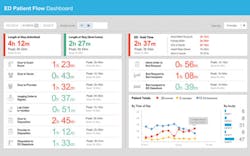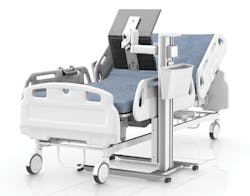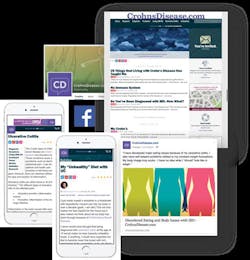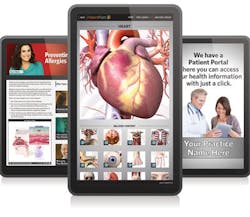Engaging patients with digital assistance
If the healthcare reformation movement accomplished any significant change indelibly seared to the American culture and zeitgeist, it’s this: Patients no longer remain detached spectators in the care they receive.
Forget about merely paying a monthly insurance premium, perching on the sidelines and then jumping onto an administrative and clinical conveyor belt for service. Patients no longer tacitly delegate decisions about coverage, delivery, procedures and services to third-party designees — namely, clinicians, administrators and payers that determine, if not dictate the care received and appropriate compensation.
With rising prices stemming in part from rising costs and revenue protections, patients as consumers welcome the challenge to participate anyway, whether it be as simple as choosing insurance plans to providers and clinicians all the way down to the procedures performed and even the products and technologies used on them and how they were reprocessed if reusable.
From retail clinics to telehealth to smartphone apps to wearable devices, processes and technologies that engage patients and encourage their active participation in the care they receive represents the new healthcare order.
Not surprisingly, many of them take advantage of the smart phone and tablet computing cultural phenomenon through “apps” that give patients-as-consumers closer and more direct and relatively open access to their caregivers and scores of healthcare information via online portals and online health communities. Discussions also are brewing around the concept of a “Patient Centered Data Home” (PCDH), where patients can have access to their medical record at any time while their providers are automatically notified when they seek care somewhere else.
Other strategies involve simple “networking” and relationship-building, such as “concierge check-in services,” equipped with self-help kiosks and hospitality-style professionals as guidance counselors, particularly for chronic disease sufferers and navigating around check-in, registration, billing and payment.
People over tech
The healthcare-centric version of the manufacturing, retail and service industry mantra, “the customer is always right,” probably should be, “the patient should be engaged.”
If anything, healthcare seems to be shifting to a “people business,” fortified by technology.
The fiber linking patients to their healthcare, population health and to the more granular personal “precision health” care points on a concept called “connected health” that President Obama promoted as part of his healthcare reform initiative.
In fact, the President’s Cancer Panel recently touted connected health strategies and tactics that free information from the shackles of data silos as a way to improve cancer detection, prevention and research.
“Connected health is truly about people more than technologies,” stated Barbara K. Rimer, DrPH, Chair of the President’s Cancer Panel in a press release. “The time is now to ensure that connected health applications are developed and implemented to meet the needs of patients, families, and care teams and to reduce the burden of cancer in the United States.”
The Panel defined connected health as “the use of technology to facilitate the efficient and effective collection, flow, and use of health information.” The Panel’s report, “Improving Cancer-Related Outcomes with Connected Health,” indicated that “while current technologies can make tremendous contributions toward improved outcomes for cancer patients and their families and support the oncology workforce, there are significant barriers when it comes to implementing these technologies in the real world. For example, many patients cannot access their own health information or get errors in that information corrected; providers experience electronic health record fatigue and frustration due to lack of interoperability, among other challenges; and researchers do not have a central location to compile, analyze, or even access critical data.”
Perhaps noteworthy blogger, health policy advisor and patient engagement advocate Dave “e-Patient Dave” deBronkart, also a Stage IV kidney cancer survivor, stated it best in one of his podcasts with, “Patients are the most underused resource in healthcare. When patients are empowered, engaged, equipped and enabled… they can be active contributors to care.” That involves information-sharing and workflow throughout the process, he noted.
So what are some of the patient engagement technologies available and being used today? Here is a sampling.
Intelligent InSites
www.intelligentinsites.com
“Intelligent InSites helps clinics and hospitals understand and improve the patient experience with its real-time operations software and services,” noted Marnie Lange, Product Manager-Patient Flow Solutions. “InSites automatically collects location and timestamp data as patients, caregivers and mobile medical equipment interact in healthcare facilities. InSites applies logic to convert that data into visual workplaces that help care teams ensure patients don’t experience long wait times or wander outside of safe care areas.
“With location technology in place, clinics can adopt self-rooming practices that let patients bypass crowded, germ-ridden waiting rooms altogether. Registration staff can see which exam rooms are open, where the assigned physician is currently located and whether he/she is on or behind schedule. Once the best exam room is chosen, patients are given location-sensing badges and instructed to make their way to the exam room. Nurses can easily see when the patient arrives in the room with a color change on a large, shared view board. When the physician leaves an exam room, he/she can immediately see where to go next by viewing room status and patient wait time on the view board. This technology works similarly in busy emergency departments, helping managers keep the team on track to meet key performance metrics, such as door-to-provider or ED hold times. Reports and analytics help managers and improvement teams identify outliers and determine root causes of process flow issues. The result is patients spending less time overall in clinics and emergency departments and more time with caregivers.”
TeleHealth Services
www.telehealth.com
“TeleHealth Services develops, sells and supports technology and services that transform hospital televisions, tablets and mobile devices into valuable tools for consistent clinical engagement,” said Matt Barker, Vice President, Marketing. “Interactive patient engagement solutions meet both the patient and facility’s needs by optimizing information and education at the patient point of care. Through TeleHealth’s SmarTigr patient engagement system, hospital patients can be prescribed condition-specific education across the recovery continuum, browse through hospital services, order their next meal or change environmental factors such as the room temperature and lighting.
“By initially assessing the patient, customized patient education can be automated thereby improving outcomes and lowering costs for hospitals. Approximately 20 percent of the nation’s hospitals use an interactive engagement system for patient education. The other 80 percent still use paper handouts that may or may not be read or other methods that are not easily understood. Obstacles include language barriers and literacy rates. Interactive video, with condition-specific prescriptions for learning, is a more effective medium to teach patients and families. Using the technology increases comprehension and retention up to 50 percent, and improves patient satisfaction.
“Over the past two decades, we have worked with hospitals to transform the industry from rolling carts with televisions and VHS tape players to digital, on-demand services. Today, the systems integrate smart TVs, hospital software platforms and mobile applications with a library of interactive videos designed to educate patients about their care and medications. Through electronic medical record (EMR) automation, condition-specific videos available in multiple languages are prescribed and monitored. The systems generate activity reports for staff to review, document and measure compliance and patient comprehension. Hospitals continue to leverage technology to improve care and automate processes, documenting success with data. All this is being done to optimize the patient experience, streamline care and enhance hospital revenues.”
Charleston Area Medical Center
http://camc.org
“In the first quarter of 2015, CAMC’s Multidisciplinary Patient and Family Education Council began implementing a solution to reduce readmissions with the aim of enhancing patient education and engagement to improve outcomes,” noted Donald Lilly, MD, Associate Chief Medical Officer. “The strategy included a detailed clinical assessment at admission and nurse navigators who coordinate care and a smooth transition after discharge or referrals to other facilities as appropriate. Delivering a 30-day supply of all medications to patients and providing counseling from a pharmacist prior to discharge along with ensuring follow-up appointments with primary care physicians was another part of this strategy. We included TeleHealth Services’ interactive patient education solution to help standardize education and increase engagement to support this hospital initiative.
“Educating patients to take better care of themselves is critical to success, both for the patient and the hospital. A lot of our patients have literacy issues, so reading is not the best way for them to learn. Interactive video using the patient television is an effective way for our patients to learn about their disease and how to manage their health condition. Many of our patients are visual learners and can better retain information from videos than from reading patient handouts. They spend much more time watching television than reading written material in their daily lives so it seems more natural for them. Videos along with corresponding quizzes stimulate conversation and facilitate learning for the whole family. When patients involve their own family members while they’re still in the hospital, they have more support and a greater chance of compliance once they go home. That helps to keep them from coming back to the hospital. We were able to reduce readmissions for COPD by almost 30 percent compared to the previous year. We also reduced readmissions for pneumonia and congestive heart failure.”
GCX Corp.
www.gcx.com
“GCX offers a suite of medical-grade mounting solutions that positions tablet computers for safe and comfortable use by patients,” said Cris Daugbjerg, Vice President, Development and Sales. “A number of hospitals are using tablets as part of their strategy to engage patients more in their course of care. Our new over-bed table with an integrated tablet mounting arm has been a popular option because it usually replaces an existing table rather than adding more physical equipment in the room. We also have compact rolling stands and longer wall-mounted arms that may be appropriate, depending on the department and use case. A number of software companies are introducing great products in the patient engagement space, but we’ve seen patients delighted to gain even the basic ability to access their Netflix, Facebook, or Skype accounts.”
Health Union
https://health-union.com
Lauren Lawhon, COO, Health Union, talks about the world of “Health 2.0 where technology-wielding patients engage in participatory health practices via online health communities.
“Health Union cultivates active, engaged online health communities dedicated to serious health conditions, such as MultipleSclerosis.net, RheumatoidArthritis.net, CrohnsDisease.com, Migraine.com, Asthma.net, Type2Diabetes.com, and more. Our approach combines new, original content with digital, social and mobile technologies to harness the full power of the Internet to help people with challenging health conditions lead better lives.
“Everyone can find ‘someone like them’ among Health Union’s regular contributors and Health Union content for each condition-specific platform offers an inside view to the challenges of people with the condition. Leading patient advocates, professional medical writers, or patients themselves who represent the spectrum of patient experiences, interests, and personalities are among those who contribute content.
“Social media conversation is a cornerstone of Health Union’s online communities, reaching and engaging approximately 15 million people every month. Each post helps build a large-scale dialogue among patients through images and artwork; concise, simple and mobile-friendly copy; and opportunities to participate in polls, surveys, clinical trials, and more.
“Through Health Union platforms, people with challenging health conditions, along with friends, family, and other loved ones, can share experiences, offer support, and help promote greater understanding of their condition and its impact. Trained moderators encourage progressive and ongoing connections by responding to questions, offering suggestions, and recommending related content.
“Health Union’s series of large-scale, annual surveys of patients quantify the real impact of the condition for patients — quality of life, social relationships, self-efficacy and self-esteem, healthcare professional engagement, treatment behaviors and barriers — and to track changes in patient experiences over time.
“Digital, social and mobile technologies can be an effective tool in helping people manage their health, but true engagement must be cultivated and nurtured over time. Online health communities uniquely combine a human element with technology. People are attracted to online health communities because the content speaks to them; patients engage over and over again because they find validation, empathy, support, and connection in the exchange of personal experience.”
NEC Display Solutions of America
www.necdisplay.com
“NEC Display Solutions offers displays that can be mounted in a face-down orientation on the ceiling of a patients’ room often showing very high-resolution imagery in a video wall application,” said Ben Hardy, Product Manager. “The life-like imagery creates a relaxing environment so that patients do not have to stare at a blank ceiling while in recovery. It’s unique because a number of NEC’s displays can actually be mounted in face-down orientation, which is rare in the display market.”
PatientPoint
http://patientpoint.com
“PatientPoint Interact is a digital exam room touch screen that provides patients with health education, videos, a robust illustrated and interactive 3-D anatomical library and lifestyle information to aid patient-physician discussions,” said Chris Martini, Chief Provider Officer, and President, Hospital solutions. “The goal? Exam room-based digital patient education allows for a more patient-forward, patient-friendly and private approach that encourages honest and engaging dialogue between patients and their physicians, caregivers and nurses.
“Interact provides custom education based on health specialty or treatment phase from diagnosis to maintenance. Patients can explore interactive 3-D models of the body and its systems, watch videos and read articles to gain an understanding of their diagnosis, treatment options and resources available to them…all with a few taps of a finger in the privacy of the exam room. When paired with physician interaction, technology innovations such as Interact aid patients in understanding and making decisions about their health.
“Patients are encouraged to utilize Interact through a ‘passive mode’ that is playing when the patient enters the exam room. It invites the patient to tap the screen to explore more content and provides custom messaging from the practice. By combining technology that is accessible to the patient with creative, approachable and encouraging content, providers are able to improve the experience for their patients, even while they are waiting for the physician to arrive.”
Orbita Inc.
www.orbitahealth.com
“Orbita provides health care’s first comprehensive, HIPAA-compliant, cloud-based platform designed specifically to improve the effectiveness and efficiency of connected home healthcare,” noted Nathan Treloar, President and COO. “The Orbita platform includes built-in capabilities to capture and analyze data from wearables, sensor-embedded home health devices, and other connected devices — and make this data meaningful and actionable through intuitive, collaborative care experiences that engage patients, empower their caregivers, including professionals, family members and friends, and inform their healthcare providers.
“Orbita’s solution enables a 360-degree view of patients to optimize monitoring, education, intervention, and collaboration. Orbita’s embedded functionality is used to build powerful applications and user experiences for patients, providers and caregivers for social computing, analytics (actionable insights,) content and experience management, and secure (HIPAA-compliant) cloud computing.
“Instead of spending time with traditional handwritten charting or computer-based notes entry, home care professionals can now use Orbita’s voice interaction to record their activity when they arrive, when they leave and while they’re interacting with patients. This ‘universal remote control’ of sorts can be extremely powerful for patient engagement. A patient uses voice activation for a range of care needs — to confirm he’s taken medications, to arrange transportation to a clinic or even a grocery store, or to call upon a family member for reassurance. A device like the Amazon Echo, when connected to Orbita’s platform, can replicate a significant percentage of routine home care tasks, such as Q&A, content delivery and support and coordination, while also serving as a digital triage for other more serious needs that require clinical intervention or other kinds of human intervention.”
West Monroe Partners
www.westmonroepartners.com
“A few examples that are top of mind are iTriage, and a custom built mobile application that allows doctors and physical therapists to prescribe exercise routines to their patients in order to recover from joint surgery, such as knee replacement and ACL,” said Will Hinde, Senior Director, Healthcare Practice. “iTriage is developed by iTriage LLC, a wholly owned subsidiary of Aetna. This mobile application engages customers — patients, insurance subscribers — by allowing users to conduct searches for health answers via a variety of methods, including interactive entry of symptoms. It also allows you to securely store your health information, find your prescribed medications, learn more about diseases, and find care options. The app is intuitive and easy to use, and receives high marks in reviews.
“Our custom application in beta [testing] is an interactive application designed to help patients rehabilitate at home while keeping their doctor and physical therapist informed. These exercises, such as type, number of repetitions, etc., are assigned by the provider and the user watches an avatar perform the exercise on the app. The user then mirrors that motion and the sensor movement then is mirrored by the avatar on the application, providing real time feedback on how many repetitions are performed and how precisely they are done. Through a proprietary sensor, algorithms and Bluetooth connectivity the application is able to measure both flexion and range of motion.
“These apps both engage patients in a visual way to simplify complex healthcare concepts. It’s much easier to look at an image of a body and select what hurts and choose from options than it is to conduct a broad search online or verbally describe an ailment. By leveraging information provided by the patient, these apps also help accomplish health tasks, such as find a doctor, do rehab stretches. Without an app to help facilitate and drive behavior, these activities often are left incomplete. Previous apps were too simple and formulaic and did not engage the patient in an interactive way. With gamification and lessons learned from other industries, such as retail and banking, these examples are paving the way forward for more meaningful healthcare mobile apps.”
Editor’s Note: West Monroe does not manufacture products but instead advises on and implements a variety of processes and technologies for their clients. The product mentioned is an example.
Enviah
http://enviah.com
“Enviah employs a tool called the CORE Report, which is a quantitative survey tool that provides a deep dive into staff perceptions,” said Lorissa MacAllister, PhD, AIA, NCARB, LEED AP, Founder and CEO. “Due to HIPAA compliance and operational procedure, the staff are the main portal to the patient experience and therefore the staff engage the patient in the care they receive. Therefore, for patient experience to be the best it can be, the staff need to be highly engaged and doing their best work. The CORE Report is an effective way to evaluate how staff feel about the operations, culture, and built environment and illuminates the various ways that the environment influences the way people work.”
See sidebar: What attracts, detracts from clicking and sticking?
About the Author
Rick Dana Barlow
Senior Editor
Rick Dana Barlow is Senior Editor for Healthcare Purchasing News, an Endeavor Business Media publication. He can be reached at [email protected].











